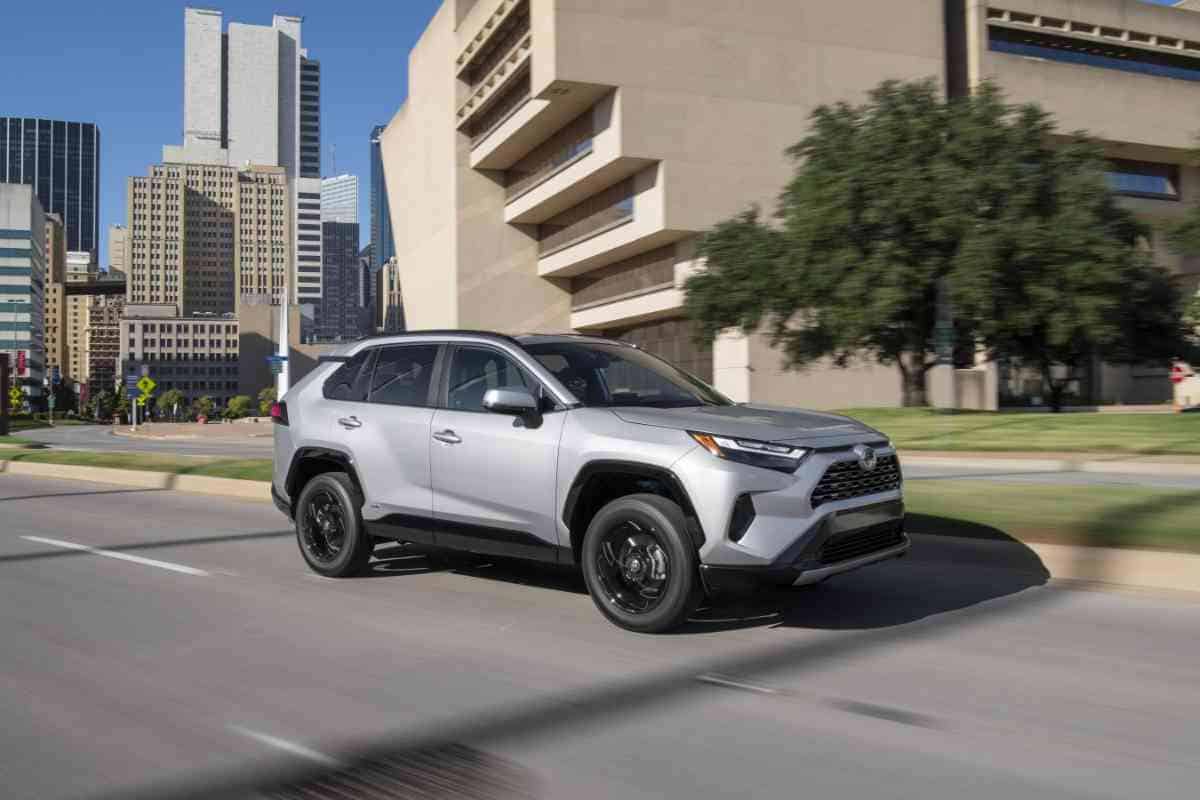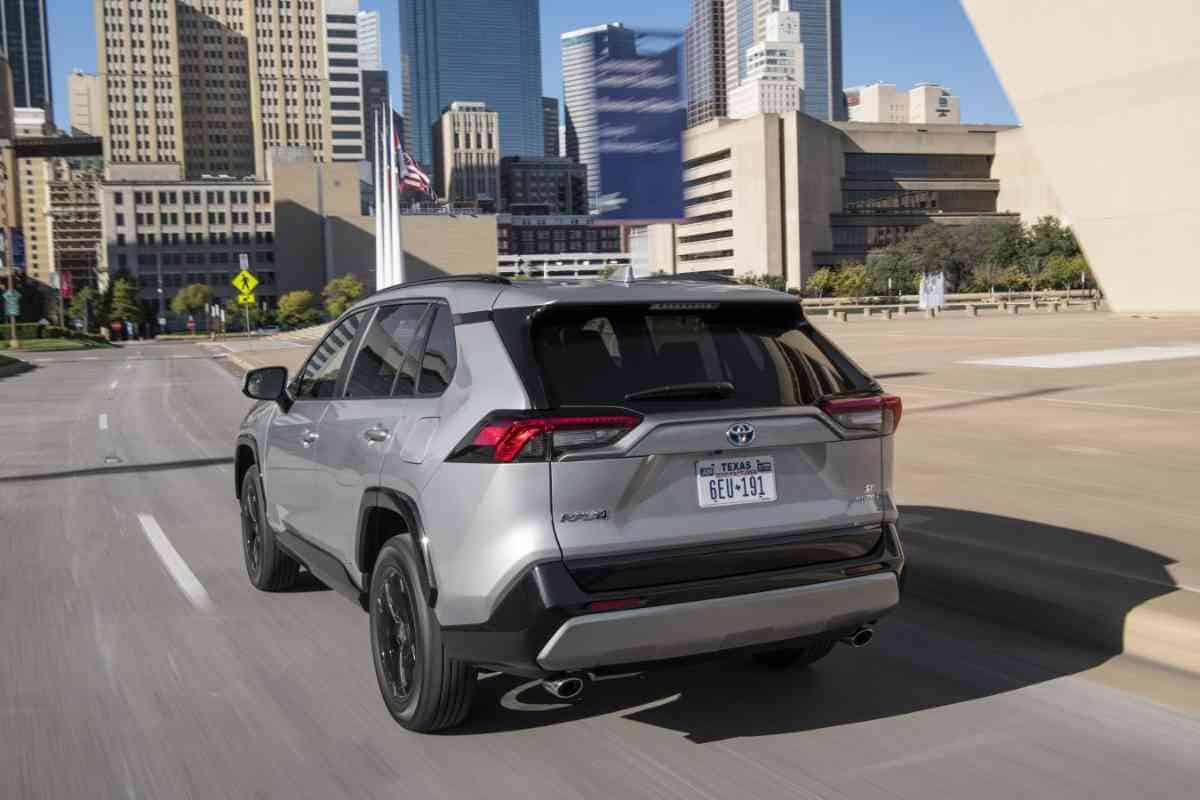How Far Can a RAV4 Hybrid Go on Battery? Exploring the Electric Range of Toyota’s Popular SUV
The Toyota RAV4 Hybrid is an excellent choice for drivers seeking a fuel-efficient SUV. By combining a gasoline engine with an electric motor, it delivers impressive fuel economy.
If you’re curious about the RAV4 Hybrid’s electric driving range and other performance aspects, you’ve come to the right place. In this article, we’ll provide valuable insights and address frequently asked questions about its electric range, reliability, and maintenance.

How Far Can a RAV4 Hybrid Go on Battery?
The RAV4 Hybrid can travel up to 42 miles on battery power alone due to its 18.1 kWh battery pack, which is larger compared to the standard RAV4 Hybrid. However, factors such as driving conditions, temperature, and battery charge level will affect the driving range of the RAV4 Hybrid.
Whether you’re curious about how far this fuel-efficient SUV can go on battery power alone or seeking insights into its reliability and maintenance, we’ve got you covered.
Delve deeper into the RAV4 Hybrid’s electric capabilities and charging options, and uncover the perfect balance between eco-friendly driving and impressive performance.
Key Takeaways:
- The RAV4 Hybrid offers an electric driving range of up to 42 miles, allowing for emission-free driving under ideal conditions.
- Factors such as driving conditions, temperature, and battery charge level can affect the RAV4 Hybrid’s electric range.
- Charging the RAV4 Hybrid can be done through a standard household outlet or a Level 2 charger, with a full charge taking up to 12 hours or 2.5 to 3 hours, respectively.
- The RAV4 Hybrid’s performance includes impressive acceleration, handling, and fuel efficiency, with an EPA-estimated rating of 40 mpg in the city and 36 mpg on the highway.
A Versatile and Efficient SUV
The RAV4 Hybrid strikes a satisfying balance between electric driving range and gasoline-powered performance. It’s a dependable and efficient SUV that excels in both daily commutes and weekend road trips. In the following section, we’ll delve deeper into the RAV4 Hybrid’s electric driving range and charging capabilities.
An Overview of the Toyota RAV4 Hybrid
The Toyota RAV4 Hybrid stands out as a popular hybrid car, seamlessly combining a gas engine with an electric motor. This versatile vehicle offers a harmonious blend of power and fuel efficiency. Let’s take a closer look at its powertrains, fuel efficiency, and capabilities.
Powertrains
Equipped with two powertrains, the RAV4 Hybrid features a 2.5-liter four-cylinder gas engine that generates 176 horsepower and 163 lb-ft of torque. The electric motor complements the gas engine, producing 118 horsepower and 149 lb-ft of torque. Together, these power sources yield a combined output of 219 horsepower.
The RAV4 Hybrid boasts an intelligent all-wheel-drive system that adjusts automatically to optimize traction and stability. With an independent electric motor powering the rear wheels, the vehicle’s performance on challenging terrains and adverse weather conditions is significantly enhanced.

Fuel Efficiency
Impressive fuel efficiency is one of the RAV4 Hybrid’s key selling points. According to Toyota’s official website, it has a fuel tank capacity of 14.5 gallons. For city driving, this translates to an estimated range of 594.5 miles per tank. The RAV4 Hybrid achieves an impressive fuel economy rating of 40 miles per gallon in the city and 36 miles per gallon on the highway.
Capability
The RAV4 Hybrid demonstrates remarkable capability across diverse driving conditions. With a towing capacity of up to 1,750 pounds, it is well-suited for towing small trailers or boats. The vehicle boasts a ground clearance of 8.1 inches, making it suitable for off-road adventures.
Additionally, the RAV4 Hybrid offers multiple driving modes, including EV, Eco, Normal, and Sport. The EV mode allows short-distance travel using electric power alone, while the Eco mode optimizes fuel efficiency. The Normal mode strikes a balance between power and efficiency, and the Sport mode enhances throttle response and sharpens handling.
In summary, the Toyota RAV4 Hybrid is a versatile and capable SUV that seamlessly combines power and fuel efficiency. With its impressive powertrains, commendable fuel economy, and versatile capabilities, it represents an appealing choice for those seeking a practical and eco-friendly vehicle.
Exploring the Electric Driving Range and Charging of the RAV4 Hybrid
The Toyota RAV4 Hybrid stands out as a popular choice for drivers seeking a fuel-efficient and eco-friendly SUV. One of its key features is the ability to run on electric power alone. In this section, we’ll delve into the electric driving range of the RAV4 Hybrid and provide insights into its charging capabilities.
EPA-Estimated Electric Range
According to the Environmental Protection Agency (EPA), the 2023 RAV4 Hybrid boasts an impressive electric-only driving range of up to 42 miles. This estimate indicates that, under ideal conditions, the RAV4 Hybrid can travel up to 42 miles without utilizing any gasoline. However, it’s essential to remember that this figure is based on laboratory testing and may not perfectly align with real-world driving conditions.
Real-World Range

While the EPA’s estimated electric range is a helpful reference point, it’s crucial to consider that real-world driving conditions can vary significantly. Factors such as temperature, terrain, and driving style can impact the actual electric driving range of the RAV4 Hybrid.
In typical driving conditions, drivers can expect to achieve an electric-only range of approximately 30-35 miles. This represents a notable improvement compared to the gas-powered RAV4, which has an estimated combined fuel economy of 30 mpg.
It’s worth noting that the RAV4 Hybrid’s electric driving range can be extended through the utilization of its regenerative braking system. This system captures and repurposes energy that would otherwise be lost during braking, thus recharging the battery pack. By driving in a manner that maximizes regenerative braking, drivers can potentially further extend their electric driving range.
Overall, the RAV4 Hybrid’s electric driving range serves as a compelling advantage for eco-conscious drivers who aim to reduce their environmental impact and save on fuel costs. While the EPA’s estimated range may not directly mirror real-world conditions, the RAV4 Hybrid’s electric capabilities remain impressive and worth considering.
Charging the RAV4 Hybrid
Charging the RAV4 Hybrid is conveniently possible through a standard household outlet or a Level 2 charger. The charging time varies depending on the charging method used and the current state of charge of the battery.
Charging Time
When utilizing a standard household outlet, the RAV4 Hybrid may take up to 12 hours to achieve a full charge. However, opting for a Level 2 charger significantly reduces the charging time, typically requiring approximately 2.5 to 3 hours to fully charge the battery.
Charging Stations
Charging stations are becoming increasingly accessible, simplifying the process of charging the RAV4 Hybrid while on the go. Many public charging stations offer Level 2 charging capabilities, enabling a shorter charging time compared to standard household outlets.
It’s important to note that the RAV4 Hybrid can also recharge its battery through regenerative braking. This innovative system converts a portion of the energy dissipated during braking into electricity, which is then utilized to replenish the battery.
When the battery is fully charged, the RAV4 Hybrid can operate in EV mode for up to 1.5 miles at speeds of up to 25 mph. This feature proves useful for short trips in urban areas or within parking lots.
Additionally, it’s worth mentioning that the RAV4 Hybrid includes a warranty for the hybrid battery. This warranty covers the battery for 10 years or 150,000 miles, offering owners peace of mind regarding their battery’s coverage for a substantial duration.
Performance of the RAV4 Hybrid
The RAV4 Hybrid strikes a perfect balance for drivers seeking an SUV that combines fuel efficiency with impressive performance. Its electric motor and battery pack seamlessly integrate with the gasoline engine to deliver a smooth and efficient ride. Let’s delve into the RAV4 Hybrid’s performance in terms of acceleration and handling.
Acceleration
With a combined output of 219 horsepower, the RAV4 Hybrid can accelerate from 0 to 60 mph in just 7.8 seconds. The electric motor’s instant torque provides excellent acceleration, particularly at lower speeds. Furthermore, the electric motor’s assistance reduces the load on the gasoline engine, enhancing overall efficiency.
Handling
Thanks to its low center of gravity, the RAV4 Hybrid offers exceptional handling and stability. The battery pack’s placement beneath the rear seats contributes to even weight distribution and improved balance. Additionally, the RAV4 Hybrid features a sport-tuned suspension that ensures a comfortable ride while maintaining agile handling.
Efficiency
In terms of fuel efficiency, the RAV4 Hybrid impresses with an EPA-estimated rating of 41 mpg in the city and 38 mpg on the highway. The electric motor and battery pack enable electric-only operation at low speeds, resulting in improved fuel efficiency during stop-and-go traffic conditions.
Reliability and Maintenance of the RAV4 Hybrid

When it comes to reliability and maintenance, the RAV4 Hybrid excels as a dependable vehicle with minimal upkeep requirements. Here are some key points to consider:
Battery Life
The lifespan of the RAV4 Hybrid’s battery varies depending on driving habits and conditions. However, Toyota provides an 8-year/100,000-mile warranty on the hybrid battery, offering peace of mind to owners. This warranty covers any defects in materials or workmanship, ensuring that you won’t have to bear the cost of battery replacement if a premature failure occurs.
Warranty
In addition to the hybrid battery warranty, the RAV4 Hybrid comes with a 3-year/36,000-mile basic warranty and a 5-year/60,000-mile powertrain warranty. These warranties encompass various components, including the engine, transmission, and drivetrain. Toyota also provides extended warranties for those seeking additional coverage.
Parts and Service
Toyota boasts an extensive network of dealerships and service centers, making it convenient to find genuine parts and reliable service for your RAV4 Hybrid. The cost of maintenance is reasonable, with routine services such as oil changes and tire rotations typically ranging from $50 to $100. Moreover, the RAV4 Hybrid’s design emphasizes reduced maintenance requirements compared to traditional gas-powered vehicles, resulting in long-term cost savings.
Overall, the RAV4 Hybrid is a dependable and low-maintenance vehicle supported by robust warranty coverage. If you desire a vehicle that is hassle-free to own and operate, the RAV4 Hybrid stands out as an exceptional choice.
Cmaprison With The Rave4 Prime And Other Plug-In Hybrids
The Toyota RAV4 Hybrid and RAV4 Prime are two popular choices for drivers seeking a fuel-efficient and eco-friendly SUV. While they have similarities, there are notable differences that can help inform your purchasing decision. Let’s compare the RAV4 Hybrid and RAV4 Prime, as well as other plug-in hybrids on the market.
Electric-Only Driving Range
The RAV4 Hybrid is a non-plug-in hybrid that relies on its hybrid powertrain, featuring a 2.5-liter four-cylinder engine and two electric motors. It does not have an electric-only driving range, achieving an EPA-estimated 41 mpg in the city and 38 mpg on the highway.
In contrast, the RAV4 Prime is a plug-in hybrid with a larger battery pack, allowing it to travel up to 42 miles on electric power alone. This means shorter trips can be made solely on electric power without using any gasoline. Once the electric range is depleted, the RAV4 Prime functions as a traditional hybrid and achieves an EPA-estimated 94 MPGe.
Fuel Economy
Both the RAV4 Hybrid and RAV4 Prime offer impressive fuel efficiency. The RAV4 Prime has a slight advantage, with an EPA-estimated combined fuel economy rating of 38 mpg when running on gas compared to the RAV4 Hybrid’s 40 mpg. However, when running on electric power alone, the RAV4 Prime boasts an impressive 94 MPGe, while the RAV4 Hybrid achieves 41 mpg.
Price and Trim Levels
The RAV4 Hybrid is available in four trim levels: LE, XLE, XSE, and Limited. Prices range from $28,350 for the LE to $37,030 for the Limited. The RAV4 Prime is offered in three trim levels: SE, XSE, and XSE Premium. Prices start at $39,275 for the SE and go up to $47,925 for the XSE Premium.
While the RAV4 Prime carries a higher price tag, it comes with more standard features, including a larger infotainment screen, wireless charging, and a power liftgate. Moreover, depending on the buyer’s tax situation and location, the RAV4 Prime may qualify for federal tax credits.
All-Wheel Drive
Both the RAV4 Hybrid and RAV4 Prime come equipped with all-wheel drive as standard, making them suitable for areas with inclement weather or off-road excursions. The RAV4 Hybrid utilizes a mechanical system that engages the rear wheels when needed, while the RAV4 Prime employs an electric motor to power the rear wheels, enhancing traction and control.
Overall, the RAV4 Prime is an excellent option for those desiring a plug-in hybrid with an extended electric-only driving range and additional standard features. However, the RAV4 Hybrid remains a more affordable choice that still delivers excellent fuel economy and all-wheel drive capability.
Conclusion
The Toyota RAV4 Hybrid is a versatile and efficient SUV that offers a harmonious blend of power and fuel economy. With its impressive electric driving range of up to 42 miles, drivers can enjoy extended periods of emission-free driving. The RAV4 Hybrid’s electric capabilities, combined with its reliable performance and low maintenance requirements, make it an appealing choice for eco-conscious drivers seeking an SUV that reduces their environmental impact.
In comparison to the RAV4 Prime and other plug-in hybrids, the RAV4 Hybrid holds its own as a non-plug-in hybrid. While it lacks an electric-only driving range, it compensates with a fuel-efficient powertrain and all-wheel-drive capability. The RAV4 Prime, on the other hand, offers a longer electric range and additional features but comes at a higher price point. Ultimately, the choice between the RAV4 Hybrid and RAV4 Prime depends on individual preferences and budget.
Overall, the Toyota RAV4 Hybrid is a reliable, low-maintenance SUV that delivers impressive fuel efficiency and a seamless driving experience. Its electric capabilities and efficient powertrains make it a standout choice for drivers seeking an eco-friendly vehicle without compromising on performance or versatility.
FAQs
What is the estimated range of a Toyota RAV4 Hybrid on battery power?
The estimated range for electric-only driving in the RAV4 Hybrid is a few hundred meters to about 0.6 miles (1 km) depending on the circumstances.
Can the Toyota RAV4 Hybrid run on battery power alone?
Yes, the RAV4 Hybrid can run on battery power alone under certain conditions, such as at low speeds and under light loads.
How does the RAV4 Hybrid’s battery range compare to the RAV4 Prime?
The RAV4 Prime has a larger 18.1-kWh battery pack and can travel up to 42 miles on electric-only power, while the RAV4 Hybrid’s electric-only driving range is much shorter.
What is the average MPG for the 2023 Toyota RAV4 Hybrid?
The 2023 Toyota RAV4 Hybrid has an estimated fuel economy of 41 mpg in the city and 38 mpg on the highway.
How much cargo space is available in the RAV4 Hybrid compared to the RAV4 Prime?
The RAV4 Hybrid and RAV4 Prime have similar cargo capacities, with the RAV4 Hybrid offering 37.6 cubic feet of cargo space behind the rear seats and 69.8 cubic feet with the rear seats folded down. The RAV4 Prime offers slightly less cargo space due to the larger battery pack.
Is the price of the RAV4 Plug-In Hybrid worth the extra cost compared to the RAV4 Hybrid?
The RAV4 Prime is more expensive than the RAV4 Hybrid due to its larger battery pack and additional features. Whether or not the extra cost is worth it depends on individual needs and preferences, such as the desire for a longer electric-only driving range.
